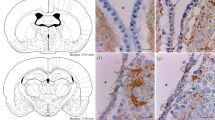Summary
The course and distribution of the glial fibres and the structure of the ependyma have been investigated in the pineal gland of adult cats. The following features are shown to be characteristic:
-
1.
In the rostral parts of the outer surface there is a regular layer of marginal glial fibres. In the more caudal parts of the surface the fibres are less numerous and more irregularly arranged. At the tip fo the organ some of the fibres penetrate into the connective tissue of the pia mater.
-
2.
The inner surface of the pineal gland is characterized by the absence of a continuous layer of subependymal glial fibres. The ependymal cells are in close contact with the cells of the parenchyma. The nuclei of the ependymal cells are often bizarre and there are large nuclear inclusions.
-
3.
In the interior of the organ there is an irregular network of glial fibres. Between these fibres thick structures with a diameter of 2–4,5 μ have been found. These structures are shown to be bundles of glial fibres which run parallel in close contact for about 6–60 μ before they fan out like the hairs of a brush.
Zusammenfassung
Verlauf und Verteilung der Gliafasern sowie der ependymale Wandbau in der Epiphysis cerebri der erwachsenen Katze werden untersucht. Dabei ergeben sich folgende Gesetzmäßigkeiten:
-
1.
An der äußeren Oberfläche des Organs befindet sich rostral eine geordnete Schicht marginaler Gliafasern, während caudal von dieser Region die Fasern unregelmäßig verlaufen, weniger zahlreich sind und gelegentlich in die Pia mater einstrahlen.
-
2.
An der inneren Oberfläche fehlt eine durchgehende Schicht subependymaler Gliafasern. Das Ependym liegt direkt über den Zellen der Epiphyse und ist durch bizarre Kernformen und große Kerneinschlüsse gekennzeichnet.
-
3.
Im Organinneren bilden die Gliafasern ein Geflecht. Neben zahlreichen einzeln verlaufenden Fasern findet man ungewöhnlich dicke Gebilde, die 2–4,5 μ breit und 6–60 μ lang sind. Es handelt sich um Bündel von Gliafasern, die sich für ein Stück ihres Verlaufes dicht aneinander legen, um dann wieder pinselartig aufzusplittern.
Similar content being viewed by others
Literatur
Bargmann, W.: Die Epiphysis cerebri. In: W. V. Möllbndorff, Handbuch der mikroskopischen Anatomie des Menschen, Bd. VI/4. Berlin: Springer 1943.
Dimitrowa, Z.: Recherches sur la structure de la glande pinéale chez quelques mammifères. Névraxe 2, 259–321 (1901).
Feldberg, W., and K. Fleischhauer: Penetration of bromophenol blue from the perfused cerebral ventricles into the brain tissue. J. Physiol. (Lond.) 150, 451–462 (1960).
Fleischhauer, K.: Fluorescenzmikroskopische Untersuchungen an der Faserglia. Z. Zellforsch. 51, 467–496 (1960).
—: Regional differences in the structure of the ependyma and subependymal layers of the cerebral ventricles of the cat. In: S. Kety and J. Elkes (ed.), Regional neurochemistry. Oxford-London-New York-Paris: Pergamon Press 1961.
—: Fluorescenzmikroskopische Untersuchungen über den Stofftransport zwischen Ventrikelliquor und Gehirn, Z. Zellforsch. 62, 639–654 (1964).
Kappers, A. J.: Survey of the innervation of the epiphysis cerebri and the accessory pineal organs of vertebrates. In: J. Ariens Kappers and J. P. Schadé (ed.), Structure and function of the epiphysis cerebri. Progr. in Brain Research, vol. 10. Amsterdam-London-New York: Elsevier Publ. Co. 1965.
Krabbe, K. H.: Recherches histologiques sur la glande pinéale. Thèse de Paris 1915. Zit. nach W. Bargmann, 1943.
Romeis, B.: Mikroskopische Technik, 15. Aufl. München: Leibniz 1948.
Wislocki, G. B., and E. H. Leduc: Vital staining of the hematoencephalic barrier by silver nitrate and trypan blue, and cytological comparisons of the neurohypophysis, pineal body, area postrema, intercolumnar tubercle and supraoptic crest. J. comp. Neurol. 96, 371–414 (1952).
Zach, B.: Topographie und mikroskopisch-anatomischer Feinbau der Epiphysis cerebri von Hund und Katze. Zbl. Vet.-Med. 7, 273–303 (1960).
Author information
Authors and Affiliations
Additional information
Mit dankenswerter Unterstützung durch die Deutsche Forschungsgemeinschaft.
Rights and permissions
About this article
Cite this article
Kusche, P. Über Ependym und Gliafasern in der Epiphyse der erwachsenen Katze. Z. Zellforsch. 71, 405–414 (1966). https://doi.org/10.1007/BF00332588
Received:
Issue Date:
DOI: https://doi.org/10.1007/BF00332588



